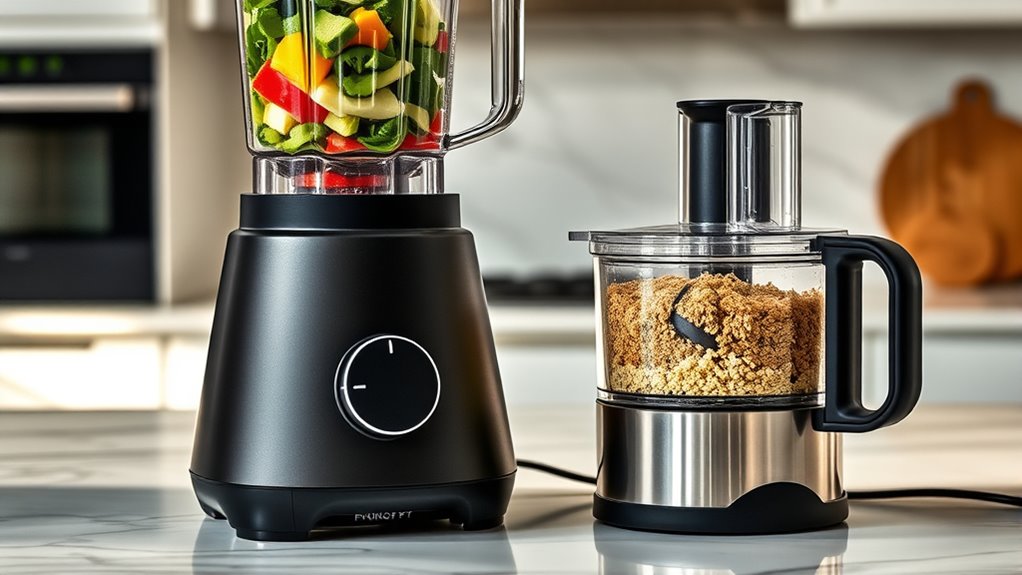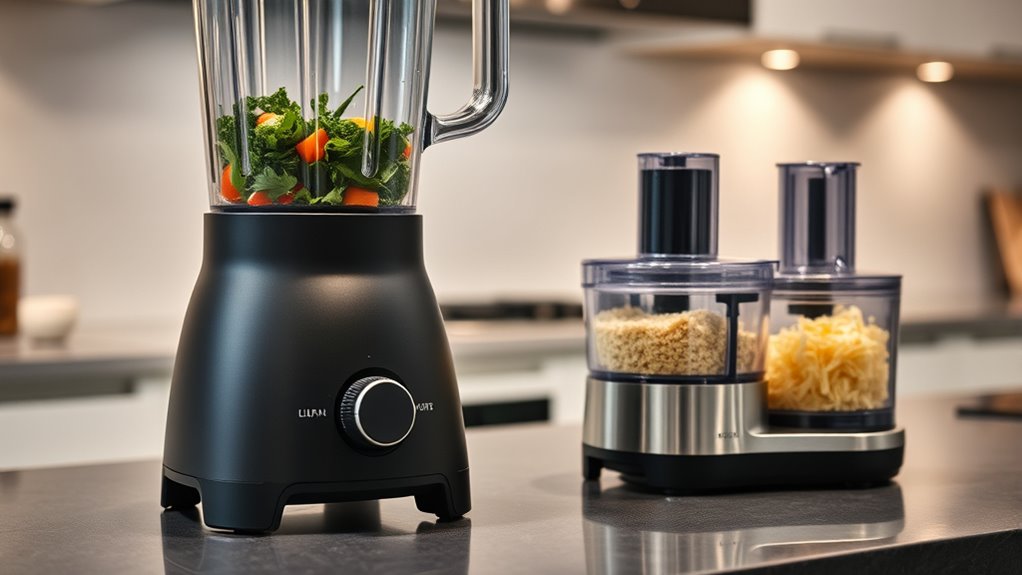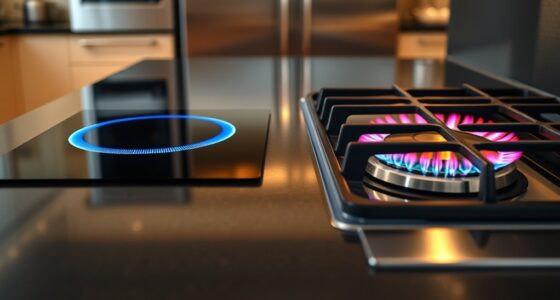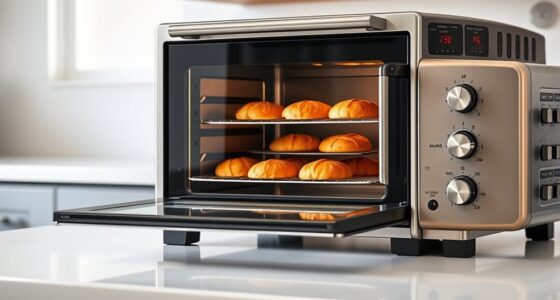High-end blenders are great for making smoothies, purees, and silky sauces, but they can’t replace a food processor for tasks like chopping, shredding, or kneading dough. They lack the versatility of attachments needed for diverse prep work and often struggle with tougher ingredients. While some blenders try to do more, they generally don’t match the efficiency of a dedicated food processor. Keep exploring to discover how each appliance complements your kitchen.
Key Takeaways
- High-end blenders excel at smoothies and purees but lack the versatility for chopping, shredding, or kneading dough.
- Food processors offer multiple attachments for various prep tasks, which blenders generally cannot replicate.
- While some blenders handle light food processing, they rarely match the efficiency of dedicated food processors.
- For tasks like slicing, grating, or kneading, a food processor is more effective and time-saving.
- Overall, high-end blenders complement but do not fully replace the multifunctionality of food processors.

When choosing kitchen appliances that can handle a variety of tasks, understanding the differences between high-end blenders and food processors is essential. High-end blenders excel at precision blending, offering smooth textures for smoothies, purees, and soups. Their powerful motors and sharp blades enable you to achieve consistent results, especially when working with tough ingredients like nuts, seeds, or frozen fruit. If your goal is to create silky drinks or finely blended sauces, a high-end blender provides the control needed to get professional-quality textures. Additionally, some blenders feature multiple functions, such as heating capabilities or specialized modes, but they still lack the full versatility of a dedicated food processor. Blenders are designed primarily for liquid and soft ingredient processing, and they often struggle with chopping, slicing, or kneading dough.
Food processors, on the other hand, are built for adaptability. They come with a variety of attachments and blades that allow you to chop, shred, grate, knead, and even knead dough. This makes them indispensable for prepping ingredients, from finely dicing vegetables to making pastry dough or grinding nuts into butter. Their precision in chopping and slicing means you can prepare ingredients quickly and uniformly, saving you time and effort. While some high-end blenders claim to handle certain food processing tasks, they rarely match a dedicated food processor’s ability to perform multiple functions efficiently. The attachments and design of food processors are optimized for a broad range of tasks, making them more adaptable for various recipes and prep work.
In essence, a high-end blender is your go-to for achieving smooth, well-blended results with precision. It’s perfect when your focus is on creating liquids, purees, or smoothies with a silky consistency. Meanwhile, a food processor’s strength lies in its adaptability in the kitchen. It handles a wider array of tasks, from chopping to shredding to kneading, making it a more all-encompassing tool for meal prep. If you’re debating whether a high-end blender can replace a food processor, it’s important to recognize that each appliance has its unique strengths. While some high-end models are versatile enough to cover some food processing needs, they generally don’t fully replace the range of functions that a dedicated food processor offers.
Frequently Asked Questions
Can High-End Blenders Handle Dough Mixing?
High-end blenders aren’t ideal for dough kneading or bread making. While they excel at blending smoothies and soups, their powerful motors can struggle with the stiff, sticky textures needed for dough. You might get some mixing done, but for proper bread making, a food processor or stand mixer is better suited. These tools handle heavy dough kneading efficiently, ensuring your bread turns out perfect every time.
Are High-End Blenders More Durable Than Food Processors?
When comparing durability, you’ll find high-end blenders often excel in material quality, making them quite resilient for daily use. While food processors typically handle tougher tasks like chopping and kneading, blenders are designed for smooth blending and liquid preparation. The durability comparison shows that high-end blenders are built with sturdy materials, but for heavy-duty chopping or slicing, a food processor might still be your best bet.
Do High-End Blenders Require Special Maintenance?
High-end blenders do require some special maintenance to keep them running smoothly. You should follow proper cleaning routines, such as disassembling and washing the blades and container regularly. Additionally, check your warranty coverage to understand what repairs or replacements are included. By maintaining your blender properly, you guarantee peak performance and longevity, making it a reliable tool for your kitchen.
Can High-End Blenders Replace All Food Processing Tasks?
Imagine a device that promises to do it all—powerful, quiet, efficient. But can a high-end blender truly replace a food processor? While they excel at smoothies and purees, their power efficiency and noise levels might limit their versatility. For tasks like chopping or kneading, you’ll still need a dedicated processor. So, while impressive, a blender can’t fully replace all food processing tasks, especially those requiring specialized tools.
What Safety Features Do High-End Blenders Offer?
High-end blenders prioritize safety with features like motor safety, which automatically shuts off if overheating occurs, and blade locking mechanisms that ensure blades stay secure during use. These safety features protect you from accidents and injuries, giving you peace of mind while blending or processing ingredients. You can confidently operate your high-end blender, knowing that it’s designed with your safety in mind, making your kitchen experience safer and more efficient.
Conclusion
While high-end blenders can handle many tasks traditionally done by food processors, they might not replace them entirely. Think of it like a Swiss Army knife—you have a versatile tool, but sometimes you need a dedicated knife or screwdriver. If you often process large quantities or specific textures, a food processor might still be your best bet. Remember, don’t put all your eggs in one basket; choose the right tool for each task to get perfect results.









